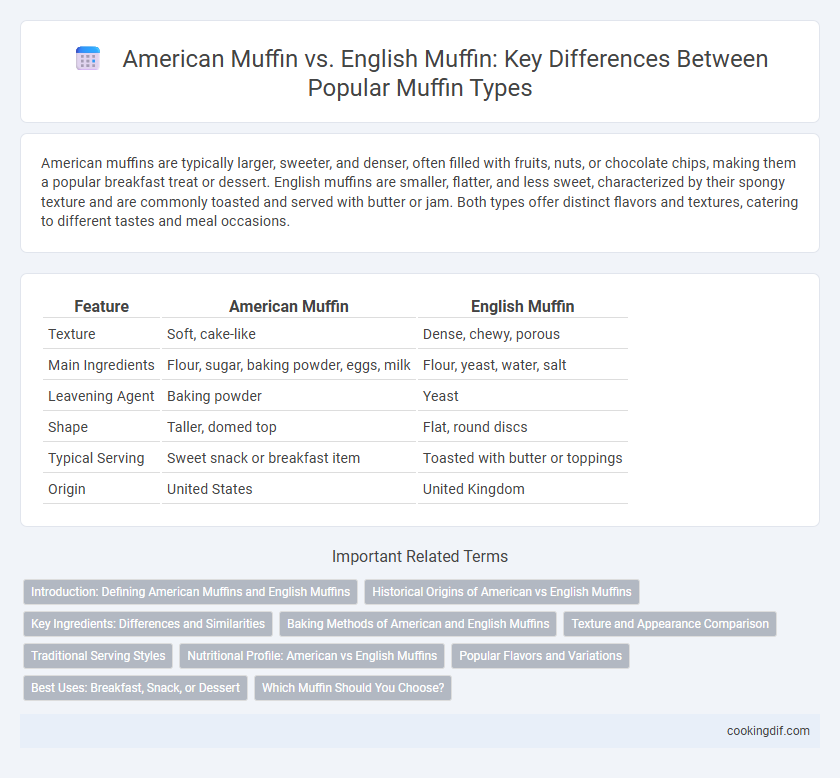American muffins are typically larger, sweeter, and denser, often filled with fruits, nuts, or chocolate chips, making them a popular breakfast treat or dessert. English muffins are smaller, flatter, and less sweet, characterized by their spongy texture and are commonly toasted and served with butter or jam. Both types offer distinct flavors and textures, catering to different tastes and meal occasions.
Table of Comparison
| Feature | American Muffin | English Muffin |
|---|---|---|
| Texture | Soft, cake-like | Dense, chewy, porous |
| Main Ingredients | Flour, sugar, baking powder, eggs, milk | Flour, yeast, water, salt |
| Leavening Agent | Baking powder | Yeast |
| Shape | Taller, domed top | Flat, round discs |
| Typical Serving | Sweet snack or breakfast item | Toasted with butter or toppings |
| Origin | United States | United Kingdom |
Introduction: Defining American Muffins and English Muffins
American muffins are soft, cake-like baked goods characterized by a sweet flavor and a tender crumb, often enjoyed as a dessert or breakfast item. English muffins are round, flat yeast-leavened breads with a chewy texture and a slightly tangy taste, typically toasted and served with butter or toppings. Both types differ significantly in texture, preparation methods, and culinary uses, defining their unique place in baking traditions.
Historical Origins of American vs English Muffins
American muffins trace their origins to quick bread recipes popularized in the 19th century, evolving as sweet, cake-like individual cakes baked in molds. English muffins, rooted in the Victorian-era United Kingdom, emerged as small, flat yeast-leavened breads cooked on a griddle, often referred to as "crumb cakes" or "English muffins." The historical distinction lies in American muffins' baking method and sweet flavor profile versus the English muffin's yeast-based fermentation and griddle preparation.
Key Ingredients: Differences and Similarities
American muffins typically contain a batter made from flour, sugar, eggs, milk, and baking powder, resulting in a sweet, cake-like texture, while English muffins use a dough of flour, water or milk, yeast, and a pinch of sugar, creating a denser, bread-like crumb. Both types share core ingredients such as flour and a leavening agent, but American muffins rely on chemical leaveners like baking powder, whereas English muffins depend on yeast fermentation for rise. Despite these differences, both muffins offer versatility in flavor and can be customized with additional ingredients like fruits, nuts, or spices.
Baking Methods of American and English Muffins
American muffins are typically baked using a quick bread method, which involves chemically leavening agents like baking powder or baking soda to create a moist, cake-like texture. English muffins, on the other hand, are made through a yeast-based fermentation process, resulting in a denser, chewier crumb with characteristic nooks and crannies ideal for holding butter and toppings. The baking technique for English muffins includes griddle cooking, whereas American muffins are baked entirely in an oven.
Texture and Appearance Comparison
American muffins exhibit a dense, cake-like texture with a domed top, often featuring a moist crumb and a variety of mix-ins such as blueberries or chocolate chips. In contrast, English muffins possess a flat, disc shape with a chewy texture and a distinctive nooks-and-crannies interior ideal for absorbing butter and spreads. The visual difference highlights American muffins as soft and puffy, while English muffins display a rough, slightly browned exterior suited for toasting.
Traditional Serving Styles
American muffins are typically sweet, dense, and cake-like, often served as breakfast or a snack with butter, jam, or cream cheese. English muffins feature a flatter, crumpet-like texture with a chewy interior, traditionally split and toasted before being topped with butter or used as the base for Eggs Benedict. The serving style highlights American muffins as individual, portable cakes, while English muffins emphasize toasting and topping versatility.
Nutritional Profile: American vs English Muffins
American muffins are typically larger and sweeter, containing higher amounts of sugar and fat, resulting in a calorie count averaging around 400-500 calories per muffin. English muffins are smaller, lower in sugar and fat, and usually contain about 120-150 calories, making them a lighter option. Nutritionally, English muffins offer fewer carbohydrates and less saturated fat, while American muffins provide more protein due to added ingredients like eggs and butter.
Popular Flavors and Variations
American muffins are known for their sweet varieties such as blueberry, chocolate chip, and banana nut, often featuring a moist, cake-like texture with a domed top. English muffins are savory or plain, characterized by their flatter, crumpet-like texture with nooks and crannies, commonly served toasted with butter or jam. Popular variations of American muffins include bran and pumpkin spice, while English muffins frequently feature additions like cinnamon raisin or whole wheat for subtle flavor enhancements.
Best Uses: Breakfast, Snack, or Dessert
American muffins, characterized by their moist, cake-like texture, excel as a versatile breakfast option or sweet snack, often paired with fruits or enjoyed plain. English muffins, with their dense, chewy crumb and nooks-and-crannies, are ideal for breakfast sandwiches or toasted with butter and jam, offering a savory alternative to sweeter treats. While American muffins lean toward dessert-like sweetness, English muffins provide a savory base suited for hearty toppings and appetizers.
Which Muffin Should You Choose?
American muffins are sweet, cake-like, and often loaded with fruits, nuts, or chocolate chips, making them ideal for a breakfast dessert or snack. English muffins have a dense, chewy texture with a slightly tangy flavor, perfect for sandwiches or toasting with butter and jam. Choose American muffins for a sugary treat and English muffins for a versatile, savory base.
American muffin vs English muffin for muffin type Infographic

 cookingdif.com
cookingdif.com